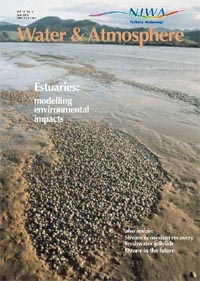
On this page
- Chief Executive succession
- NIWA’s National Centres
- NIWA scientist to take up international role
- Coastal & Storm Hazards workshop
- Sea levels on New Zealand’s eastern flank monitored
- Self-cleaning air: prize-winning research
- Filthy fumes killing us?
- SKINDEEP visits New Zealand
- Marine biodiversity – capacity-building in communities
- Granular surfaces: structure, organisation, memory
- Mapping team discovers underwater volcanoes north of New Zealand
- NIWA joins with DHI Water and Environment group
Chief Executive succession
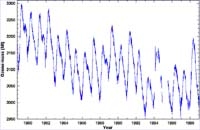
NIWA’s Chief Executive, Paul Hargreaves, will retire in August having served in this role for the past eight years. Appointed to Board of NIWA at the time of establishment of the Crown Research Institutes in 1992, Paul initially stepped in as acting Chief Executive in July 1994. During his tenure NIWA has successfully grown as a business, with turnover increasing from around $35M to more than $78M and staff numbers rising from approximately 400 to more than 600.
Dr Rick Pridmore, who has been appointed as his successor, has been with NIWA since its inception and was Research Director from 1993 to 1999. Since November 1999 Rick has held the position of Deputy Chief Executive (Strategic Development).
Born and educated in the United States, Rick holds a PhD in Zoology from the University of Otago and earlier worked with NIWA’s predecessor organisations, the Department of Scientific and Industrial Research (DSIR) and the Ministry of Works.
Rick has brought strong scientific leadership to NIWA. With his extensive knowledge of the business, its science, stakeholders and staff, he is well qualified to guide the Institute through the challenges that lie ahead.

NIWA’s National Centres
Following the success of the National Climate Centre (see Water & Atmosphere 7(3): 5) NIWA has established four further National Centres. All the centres aim to enhance the communication and application of research through regular bulletins and web page updates. Two of the newer centres are introduced below. Descriptions of the Biodiversity & Biosecurity and Climate–Energy Centres will be published in the next issue of Water & Atmosphere.
National Centre for Water Resources

Water is New Zealand’s lifeblood. We need fresh water for drinking, washing, growing food, making electricity, and much, much more. We enjoy water as a focus for picnicking and fishing and just somewhere nice to be. But we humans are not alone in our need for water. New Zealand’s rivers, lakes, wetlands and groundwater systems are also home to a wonderful variety of ecological communities.
New Zealand faces some complex questions about water resources. Will there be shortages? Do we use water wisely? How do economic activities affect water quality and quantity? How do we balance economic benefits derived from water against social and environmental costs?
To help address issues like these, NIWA established the National Centre for Water Resources in May this year.
The centre aims to bridge the gap between science and the community in the field of water resources by providing science, technology, and resource management services to New Zealand. The key role of the centre is to communicate.
The centre’s initiatives include a communication plan involving collaborating organisations and other agencies, a comprehensive web page, and a quarterly newsletter, Water Resources Update, which provides seasonal information on water quantity and quality, including river flows, water clarity, water temperatures, and groundwater levels.
National Centre for Fisheries and Aquaculture
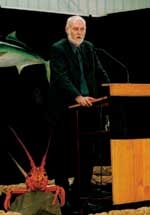
Although fisheries and aquaculture research can be seen as very different disciplines, they are closely linked in practice. The technical, biological, and ecological understanding required is similar – what differs is the application.
NIWA has strong capabilities in fisheries and aquaculture planning, development, and research that benefit from the wide blend of scientific skills available within New Zealand’s second largest Crown Research Institute. We have established a National Centre for Fisheries and Aquaculture as a gateway to provide access to this expertise.
Our goal is to help New Zealanders with the development and management of marine resources. Fisheries and aqua-culture contribute greatly to the New Zealand economy. The diversity of opportunities and issues is huge. It makes sense to use the best available information and skills to move to future sustainable industries.
The Centre has developed a web page and publishes the newsletter Fisheries and Aquaculture Update as a source of information on topical issues.

NIWA scientist to take up international role
Dr Martin Manning will become the Director of the Intergovernmental Panel on Climate Change (IPCC) Working Group I Support Unit in late 2002. The IPCC provides regular international assessments of climate change and WG I is responsible for covering the underpinning science of the physical climate system.
The new position follows the election of Dr Susan Solomon as WG I co-chair in April. Dr Solomon, who has collaborated regularly with NIWA scientists, and the new Support Unit are based in Boulder, Colorado.
Commenting on this move, Martin said, “Although I am very sad to be leaving NIWA and New Zealand, the challenge of this new opportunity is just too great to turn down. Given my broad interests in climate change science, and in presenting that science in ways that are useful outside the science community, this is close to the job I would have designed for myself. The only catch is that, although Boulder is one of the better spots in the USA, it’s a long way from a beach!”
Dr Manning will be responsible for scientific and management leadership of the WG I assessment programs as well as support for the co-chairs and report authors. The primary role will be to coordinate the IPCC WG I contribution to the Fourth Assessment Report to be completed in early 2007. The term of the appointment is for six years and Dr Manning expects to be able to continue working with New Zealand colleagues on scientific projects during that time.

Coastal & Storm Hazards workshop
What is “coastal squeeze”? What effect will global warming have on our coast? Are storms likely to increase? What information is needed by coastal resource managers to better manage a range of natural hazards? These questions and more were addressed at NIWA’s Coastal & Storm Hazards Workshop in Hamilton on 25–26 March, which was attended by over 90 people from a wide range of organisations. Brief research and sector perspectives on coastal and storm hazards were complemented by discussions exploring two questions for different types of hazards:
- What are the priorities for future scientific work if we are to improve the assessment of risk and vulnerability?
- What other information is required if we are to increase hazard awareness and build resilient, sustainable communities?
Valuable feedback outlined needs, including:
- turning “hazard information” into “risk information”;
- urgent development of a coastal margins topographic database; more open access to data;
- move from data to process-response models;
- closer links between science providers and local/regional authorities;
- better predictions on future storminess; and
- the huge planning issue of raising the public awareness of risks for seaside communities.
The Proceedings will be available as a pdf document from the Coastal Hazards web page.
For further information contact:
Rob Bell [ [email protected] ] or Terry Hume [ [email protected] ] NIWA PO Box 11-115 Hamilton Phone +64 7 856 7026 Fax +64 7 856 0151

Sea levels on New Zealand’s eastern flank monitored
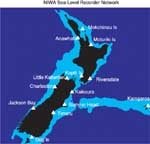
A new sea-level station has been installed at Kaingaroa on Chatham Island. A temporary station there picked up the Peru tsunami of 23 June 2001 about 2.5 hours before it reached the coast of mainland New Zealand, demonstrating the value of having a permanent station with telemetry that can give early warning of the size of tsunami waves coming from South America. The Ministry of Civil Defence and Emergency Management assisted in funding the station.
This brings to 13 the number of stations in NIWA’s network of open-coast, sea-level stations, with the recent incorporation of Timaru Port Company’s recorder into the network.
For further information contact:
Derek Goring [ [email protected] ] NIWA PO Box 8602 Christchurch Phone +64 3 348 8987 Fax +64 7 856 0151

Self-cleaning air: prize-winning research
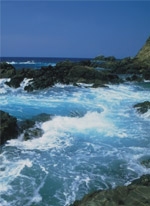
Dr Katja Riedel, currently a scientist based at NIWA in Wellington, was recently awarded the annual Bremen Study Prize for outstanding scientific achievement.
Katja, an atmospheric chemist, received the award for her doctoral thesis at the Alfred Wegener Institute for Polar and Marine Research. Her research gave new insight into self-cleansing processes in the atmosphere, and the main trace gases involved. Katja’s work in the Antarctic included the first year-round research into formaldehyde, hydrogen peroxide and methylhydro-peroxide concentrations in the lower atmosphere. These so-called photo-oxidants transform many pollutant gases and thus limit their accumulation in the air – a kind of self-purification. The research is especially relevant for understanding global climate change.
Katja’s work at NIWA includes oxygen measure-ments at the Baring Head clean air station, and the modelling of formaldehyde concentrations. She hopes to continue the investigations into formaldehyde and possibly expand her work in the near future to the analysis of air samples from Antarctic ice.

Filthy fumes killing us?
Not our words – but a NZ Herald newspaper reaction to a recent NIWA report.
In a collaborative project with universities, medical schools and consultants, NIWA undertook a study for the Ministry of Transport to assess the public health effects of vehicle emissions. The report was released by the Ministry in February 2002 and concluded that up to 1000 New Zealanders a year die prematurely because of exposure to fine particulate pollution in our urban areas. Up to 400 of these deaths were attributable to tail-pipe emissions from motor vehicles. This is of the same order as the road crash toll, at about 500 annually. The results are broadly consistent with similar studies in Europe.
The implications of this report have been widely recognised, not only within central government, but also by many Regional, District and City Councils. One follow-on has been the establishment of a new $1M joint study on health effects by the Health Research Council, the Ministry for the Environment and the Ministry of Transport. This 3-year multi-disciplinary programme aims to make a more detailed assessment, as well as identify costs and policy options for improving the situation.
The Health Report is available at www.transport.govt.nz.
For more information contact:
Gavin Fisher [ [email protected] ] NIWA Private Bag 109-695 Newmarket Auckland Phone +64 9 375 2050 Fax +64 9 375 2051

SKINDEEP visits New Zealand
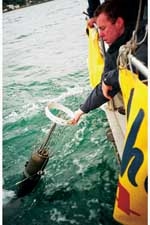
Dr Brian Ward, a visitor from Woods Hole Oceanographic Institution, Massachusetts, brought SKINDEEP, his one-of-a-kind microprofiler, out to New Zealand to take part in a joint ocean–atmosphere interaction experiment with NIWA scientists. SKINDEEP records repeated profiles of temperature and conduc-tivity in the upper few metres of the ocean surface.
This region of the sea – and its temperature and density stratification – is an area of fundamental importance in quantifying air–sea exchange of momentum and greenhouse gases. The stratification is also an issue for remote sensing because satellites that detect sea-surface temperature can measure only the top tens of micrometres, but a few cm deeper, the temperature can be significantly different.
SKINDEEP represents an evolutionary step in microprofiler technology, combining the technology of previous profilers used in NIWA’s research, such as SCAMP (see Water & Atmosphere 7(2): 20–21). A new system, TRAMP, currently under construction, will extend SKINDEEP’s capabilities to profile deeper in the water column and also to sample biological parameters.
Dr Ward’s visit was partly funded by a Royal Society International Science and Technology (ISAT/CSP) grant.
For further information contact:
Craig Stevens [ [email protected] ] NIWA PO Box 14-901 Wellington Phone +64 4 386 0300 Fax +64 4 386 5371

Marine biodiversity – capacity-building in communities
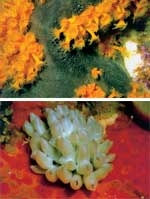
New Zealanders have an affinity for the sea – it’s very much a way of life for all of us. However, our enjoy-ment, use, conservation and protection of living marine resources depends heavily upon our knowledge of what we have (marine biodiversity), how animals and plants relate to each other (ecology), the marine environment where they live (healthy ecosystems), and how wisely we use and manage our resources (sustainability). A workshop on 24 May looked at just how NIWA can facilitate capacity-building in marine biodiversity in Maori and other communities: in other words, giving people the tools to be able to answer questions about biodiversity.
The workshop was hosted by kaumatua Maurice Wilson and Joe Matata at Makaurau Marae, Ihumatao, Auckland. The workshop brought NIWA scientists together with 53 representatives of various communities including iwi, secondary and tertiary educators, community environment groups, government agencies, marine farmers, and recreational boaties and fishermen.
Two major areas of “knowledge need” were identified through the workshop. Maori and other communities need training in assessment, management and conservation of marine biodiversity and “healthy balanced eco-systems”. And curricula for schools need to be developed to increase awareness and action in future generations. A number of downstream objectives were identified, including community workshops in recognition and classification of marine biodiversity (native and introduced marine life), and field guides in Te Reo Maori and other Polynesian and Asian languages.
Although the level of knowledge and interest in the participants was considerable, the majority of individuals and communities are largely unequipped to access, process, and utilise essential scientific information generated within the marine scientific community. The workshop provided a highly successful model for showcasing NIWA science to various (generally non-scientific) communities in a very user-friendly forum, and helped individuals to identify particular NIWA scientists who might work collaboratively with them to identify research needs and to achieve their goals.
For further information contact:
Michelle Kelly [ [email protected] ] NIWA Private Bag 109-695 Auckland Phone +64 9 375 2050 Fax +64 9 375 2051

Granular surfaces: structure, organisation, memory

Is it possible to deduce from the structure of a surface made of particles – like a scree slope, or a gravel riverbed – information about how the surface was formed? This is the main question being investigated in a 3-year NIWA project: “Granular Surfaces: Structure, Organisation, Memory”.
The Marsden-funded research focuses on perhaps the most intriguing aspect of granular media: interface interactions between granular surfaces and fluids (gases and liquids), including those driven by gravity or moving fluid. Such interactions are ubiquitous on the surface of our planet and influence many geophysical, geological, and geomorphological phenomena (for example, sand dunes and ripples, landslides, avalanches on scree slopes).
The main goal of this project is to develop a conceptual model explaining the geometrical properties of granular surfaces and linking them to the underlying physical processes. In other words, this project addresses the hypothesis that granular surfaces contain a history of the processes that formed them, whether these be scree slopes in the Southern Alps, submarine avalanche slopes in the Kaikoura Canyon, gravel in the bed of a Canterbury river, or topography around Mars Pathfinder.
Last February the project team (Vladimir Nikora, Derek Goring, Ian McEwan, Jeremy Walsh, Alistair Smith, Katie Image and David Gunn) completed the first year of their research. The most exciting results relate to laboratory experiments and computer modelling of gravitation granular flows and analyses of Martian topography. For instance, the team designed, built, and tested a special laboratory system for simulating two-dimensional piles of granules, and granular flows on their surfaces (see photo).
These laboratory experiments should help in developing and testing conceptual and mathematical models linking geometry of the pile slope with avalanche dynamics. The data will be also used for verifying computer models of granular piles, which are currently under development.
For further information contact:
Vladimir Nikora [ [email protected] ] NIWA PO Box 8602 Christchurch Phone +64 3 348 8987 Fax +64 3 348 5548

Mapping team discovers underwater volcanoes north of New Zealand


A NIWA research voyage has discovered more than fifty underwater volcanoes – six as big as Mt Taranaki – between the North Island and the Kermadec Islands 1000 km to the north.
The team, led by NIWA principal scientist Dr Ian Wright, returned to Auckland in early May after spending three weeks on the research vessel Tangaroa mapping this segment of the Pacific known as the “Ring of Fire”.
Using a new swath mapping system, Simrad EM300, they were able to map more than 24,000 km2 of seafloor at resolutions as fine as 1–2 m. The new data produced images of over 50 new volcanoes – 13 of which are about 10 km or more in diameter, and 6 that are similar in size to Mt Taranaki. The largest volcano they discovered is more than 20 km in diameter and 2.5 km high, and another rises to just 65 m below the ocean’s surface.
“The results of this voyage are stunning,” said Dr Wright. “What we are doing offshore is similar to what the frontier surveyors were doing in New Zealand in the early 1800s.”
Dr Wright said they had also discovered a new caldera volcano that forms a 5-km-wide hole to a depth of about 500 m below the seafloor. Caldera volcanoes, such as Lake Taupo, are formed after huge eruptions collapse the volcanoes, forming depressions. “The volcanic processes that formed these features must have been very impressive.”
The new swath system mapped the shape of the volcanoes, and allowed individual lava flows to be identified.
More than 200 volcanic rock samples were collected from the seafloor and will be analysed by scientists from New Zealand and Germany to determine the composition of the volcanoes. Two NIWA biologists also identified significant new areas of hydrothermal-vent fauna, and took biological samples from each of the volcanoes.
Dr Wright said one of their first tasks was to give appropriate names to these volcanoes.
For further information contact:
Ian Wright [ [email protected] ] NIWA PO Box 14 901 Kilbirnie Wellington Phone +64 4 386 0300 Fax +64 4 386 2153

NIWA joins with DHI Water and Environment group

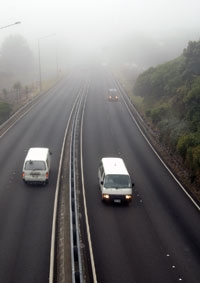
NIWA has established a partnership with the world’s leading producer of water-modelling software in response to growing demand for computer programs that predict the environmental effects of human activity.
The research partnership with the DHI Water and Environment group based in Denmark will help NIWA meet the increasing demand for its modelling services, particularly in the areas of sewer and stormwater discharges, ocean productivity, ocean outfalls, estuarine sedimentation, algal blooms, aquaculture and coastal hazards.
NIWA models coastal, shelf, estuarine and river environments for councils and commercial clients applying for resource consents. The new partnership with DHI gives NIWA access to a greater range of reliable and internationally recognised computer models, including the coastal and ocean modelling packages MIKE3 and MIKE21.
NIWA scientist John Oldman says the two packages have advantages over other models and will assist in research and consultancy in coastal and shallow inter-tidal areas.
“We can compare field data and model simulations using these packages, and they’re user-friendly. We can also examine and visualise complicated model simulations in greater detail by linking output from these models to Geographic Information Systems and sophisticated animation packages.
“Some of Auckland’s local authorities are using DHI models [like MOUSE] for their sewer and stormwater systems, and, because these models run in tandem with the MIKE3 and MIKE21 models, they’ve shown a strong preference for consultants who use these models.”
Mr Oldman says an important part of the partnership is that NIWA can have a direct involvement in the future development of the models by incorporating results from its research programmes into the modelling packages. This would benefit the growing number of DHI software users around the world.
“We are often involved in complex projects which are on the cutting edge of current modelling technology. Because of this, we need to be able to make innovative changes to the models for specific applications. This partnership allows us to do this.”
DHI Water and Environment is an independent and international consulting and research organisation with offices around the world. DHI’s Australian office has been closely involved in the partnership. DHI specialises in software and services to the water industry and has conducted projects in more than 140 countries.
For further information contact:
John Oldman [ [email protected] ] NIWA PO Box 11-115 Hamilton Phone +64 7 856 7026 FAx +64 7 856 0151
